Compared to modern cars the heating system on air-cooled Volkswagens might seem a bit antiquated, a critisism fuelled by the fact that on most cars it’s seldom working at its full potential. Yet when it was conceived all those years ago it was relatively up to date – and if everything is in place as Volkswagen intended, it’s actually pretty effective…
Sadly, what tends to happen as a car passes through various different owners throughout its life is that the system isn’t kept how it should be. This means the heating doesn’t operate at full efficiency, which is why people assume the heating is terrible! So here are the 5 most common problem areas and some possible remedies to get your air-cooled VW’s cabin roasting hot again…
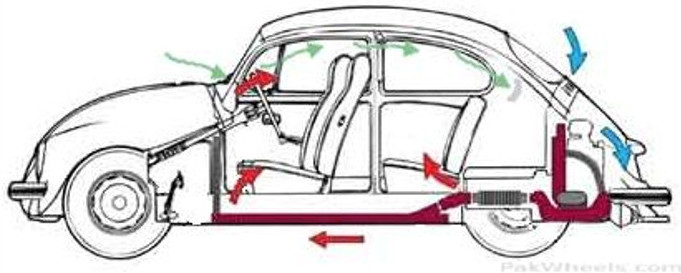
1. Heat exchangers
On an air-cooled engine air is sucked into the back of the fan housing and blown over the tops of the cylinder heads to help cool them. Air from the fan housing is also blown via the two corrugated flexible hoses either side of the engine into the heater pods then into the heat exchangers. There is a pipe with fins cast over it running through the heat exchanger which exhaust gases pass through. These fins effectively heat the air inside the exchanger which then passes into the car. The problem is, there’s lots of opportunity for this warm air to escape via rotten heat exchangers so check their condition and order new ones if they’re past their best. Beetle ones are here.
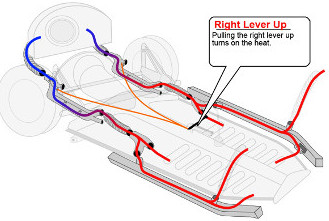
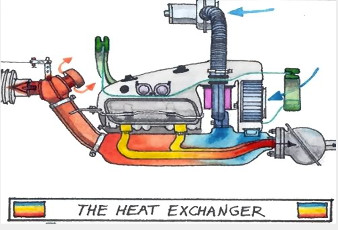
2. Heater cables
The heater controls in the car operate a flap in the heat exchangers via cables so you’ve either got hot or cold air. The control flaps are spring loaded so if the control cable snaps or is disconnected they will stay shut preventing any hot air getting into the car. The most common cause of the heaters not working is the cables not being connected to the heat exchangers, this usually happens when the engine has been removed for any reason and the cables not reconnected when the engine goes back in. Cables and various other heater bits for the Beetle can be found here.
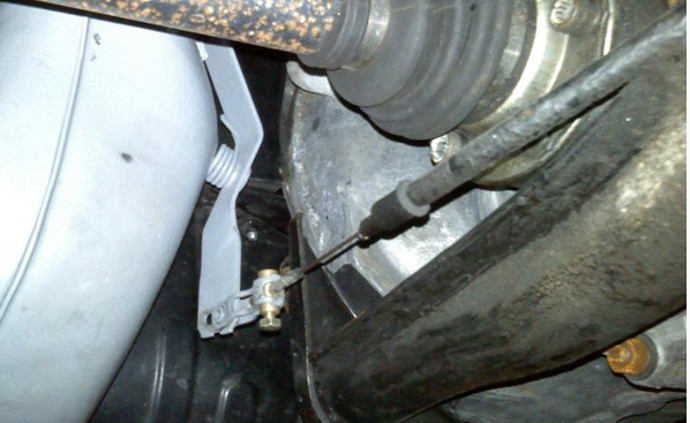
3. Fittings
It’s amazing how much warm air can be lost if fittings are missing. We’re talking here about the various jubilee type clips that secure the cardboard covered flexible heater hose to the fan housing and the metal collars that fix the sleeve that pushes into the bottom of this hose to the heater boxes on the exhaust. The clips can also be missing on the short section of flexible pipe that goes from the front of the heat exchanger into the car. There’s also a section of pipe that runs up the A-post to provide hot air to the screen vent on a Beetle, so make sure these are all in place as well.
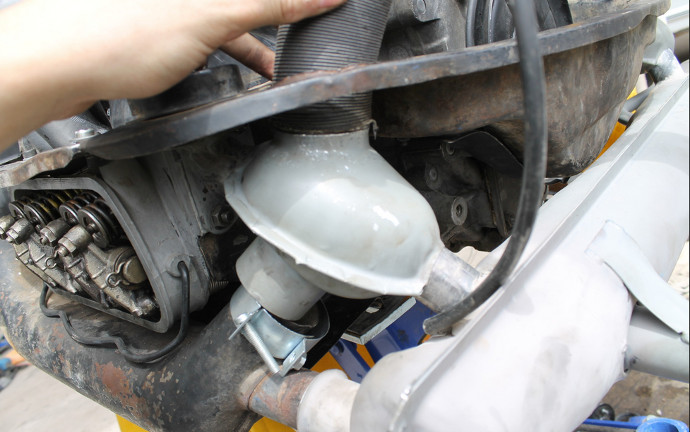
4. Heater channels
Once hot air exits the heat exchangers it passes through another piece of flexible pipework which takes it into the car’s heater channels each side. Now, we all know on a rusty car these can be the first things to go – and when they do, so will all your nice cosy warm air. The only solution is to fit replacements or weld up any holes. More often than not you will find the flexible pipes are connected to the heat exchangers correctly but without the seals in the ends causing air leaks and lack of heat. Buy replacement channels for the Beetle here.
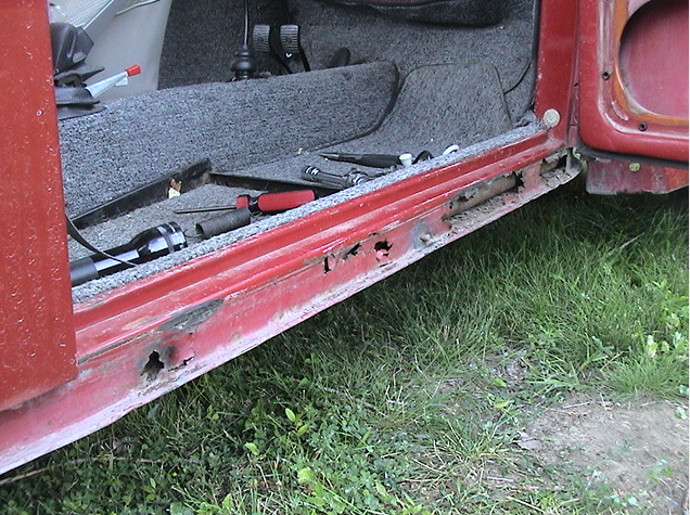
5. Leaking exhaust
If you smell smoke, then chances are your exhaust has holed and fumes are getting drawn into your heater system. The effect will be even worse if the rocker cover gasket has allowed oil to seep out over the top of the heat exchanger. Thankfully, a new gasket only costs pennies.
A big thanks to Colin from Itinerant aircooled for the use of the fantastic illustrations above. Please check out his website for a wealth of aircooled fault finding knowledge here.
Ian
The opinions expressed here are the personal opinions of the author and do not necessarily represent the views and opinions of VW Heritage


How cool. I have a dune buggy for summer and I just got a baja for wintertime fun so I could still get my off road fix. Of course the heater system is missing/hammered. I didn’t know how the heater was supposed to work but I need a defroster. Thanks for the great information.
Would you know where I could buy a blower motor for my 73 super beetle?
I am in the process of trying to fit one of these http://www.bluebird-type2.co.uk/Split%20bay%20interior.htm
I have an original nos beetle version from north America/Canada but as it made of tin and needs to be fitted under the car I thought I would try one of these plastic ones first to see I I can demist the screen…….fingers crossed
Fantastic diagram of the heat exchangers. Who’s the artist?
We’ll be honest – we don’t know, it was just a great pictorial explanation of how they work, so we used it!
We’d be happy to post a credit to the artist/link to their work should anyone know who it is though.
That would be me, Amskeptic at Itinerant Air-Cooled.com
The diagram was originally on the below-linked page as I described how the heat exchangers are not just to keep our little tushes warm, but as importantly, too cool the exhaust pipes to help draw heat out of the exhaust ports/seats . . . that is why VW had full-time air flow through the exchangers regardless of your heat control settings. (p.s. there is a copy right at the bottom of the page that tells you I am embarrassingly tardy on completing this magnum opus)
[IMG]https://i187.photobucket.com/albums/x133/73VW1800/2012%20Book/042Engine34.jpg[/IMG]
(please remove the extra “o” at “to cool the exhaust pipes” and remove the IMG tags. If you have the ability to put in URL tags, see if that works. Then remove this edit request!
-editor/proofreader, Itinerant Air-Cooled)
Hope I didn’t just miss it but what goes son under the back seat when putting the warm air in the rear foot area?
I’ve seen lots of bug engines that don’t have the heater hoses especially those with a 1835 cc dual carbs do you really need to have them?
Thanks please advise cause I maybe getting a bug with them on and I live in Florida 90 degrees all year around.
Hi there,
Thanks for the very helpful general info on the heating system.
I have 1973 VW Kombi & have done all the right things to get the heat flowing in …. but now I cant get it to go off …. the levers at the dash don’t seem to be responding to an off position.
Do you have any feedback about this … thank you.
Shanti
With regard to fans, JC Whitney used to sell inline fans that fit into the heater outlets under the back seat. I had a pair and they made a big difference, but I don’t know if they’re offered any more.
I own a 1975 vw super beetle.It was fuel injected .now carbed,my problem is the heater box control cables connecting to heater boxes.Old cables are there and move in and out using temp lever.New heater boxes and new heater hard ware installed and moves ok by hand.(The heater cables appear to short and willnot connect to heater boxes) AND if connected,heater cables will rub against half shaft boot.
Hi. I was wondering if you have any input on my dilemma. I have a 1969 Volkswagen Beetle sedan. I noticed while driving on the highway that my driverside heat was on, despite the lever being fully down. I checked the cable underneath and the functionality of the flap inside the heat exchanger. It all seemed ok, but still blew hot air. So, temporarily, I capped the fan shroud opening and the opening leading to the exchanger on the driver side. I assumed that would fix the problem, but even after capping the driver side heat, its still blowing hot air at highway speeds. If I reviewed the diagrams of the heating system correctly, the left and right sides are fed by their own airflow, correct?What are your thoughts?
I desperately look forward to your input